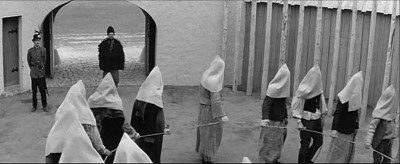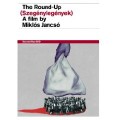| Reviews & Columns |
|
Reviews DVD TV on DVD Blu-ray 4K UHD International DVDs In Theaters Reviews by Studio Video Games Features Collector Series DVDs Easter Egg Database Interviews DVD Talk Radio Feature Articles Columns Anime Talk DVD Savant Horror DVDs The M.O.D. Squad Art House HD Talk Silent DVD
|
DVD Talk Forum |
|
|
| Resources |
|
DVD Price Search Customer Service #'s RCE Info Links |
|
Columns
|
|
|
Round-Up, The

The Round-Up is set in 1869 at a slapdash stockade-like prison on a vast Hungarian plain. The wardens are fellow Hungarians serving a native aristocracy, but the guards and their aristocratic paymasters are ultimately no freer than their detainees. They are all ultimately servile to the Austrian Empire. To maintain their privileges, the co-opted Hungarian soldiers and aristocrats persecute their downtrodden countrymen for the benefit of foreign overlords.
The jailers are tasked to determine whether any comrades of the (real-life) highwayman Rózsa Sándor are among the prisoners. The ruthless sophistication and guile of their techniques to psychologically break their captives make the methods of Abu Ghraib and Guantanamo Bay look laughably crude by comparison. By the time the film concludes, the detainees have betrayed not only one another, but also themselves.
The directorial choices evidenced in Jancsó's film from the prior year, My Way Home, mature into a body of advanced signature sylyings here: the frequent use of long takes, scenes choreographed specifically for tracking shots, minimal dialogue, emphasis on external observation and away from interior psychological states, and a theme of the vulnerability of individuals to oppression.
Presentation
The Round-up has been released from the UK-based boutique DVD label Second Run on a single dual-layered DVD which is PAL-encoded but not region restricted.
Video:
The Round-up is presented in a 2.35:1 anamorphic scope. The black and white image is clean with good detail, but suffers from edge enhancement and less than ideal contrast.
Audio:
The monaural Hungarian-language audio sounds very good with almost no distortion or hiss. The removable English-language subtitles are well translated and appropriately sized, paced, and placed.
Extras:
The disc includes a new video interview with the octogenarian Miklós Jancsó in which he supplies his personal biography and discusses technique and meaning behind The Round-up (19 min., 1.78:1 video). Also included is a 16-page booklet with an essay by John Cunningham.
Final Thoughts:
Though ostensibly a period film about events long past, every Hungarian who saw The Round-Up upon its release in 1966 would have understood it as a thinly-veiled critique of the then-current Hungarian Communist State (i.e., the Hungarian soldiers and officials persecuting fellow Hungarians at the behest of their Soviet overlords). Screened just ten years after the Communists put down the 1956 Hungarian Revolution by interning 13,000 dissidents and killing hundreds more, The Round-Up was as brave a film as it is dramatically thrilling and technically wonderful.
Highly Recommended.
|
| Popular Reviews |
| Sponsored Links |
|
|
| Sponsored Links |
|
|
| Release List | Reviews | Shop | Newsletter | Forum | DVD Giveaways | Blu-Ray | Advertise |
|
Copyright 2024 DVDTalk.com All Rights Reserved. Legal Info, Privacy Policy, Terms of Use,
Manage Preferences,
Your Privacy Choices | |||||||













